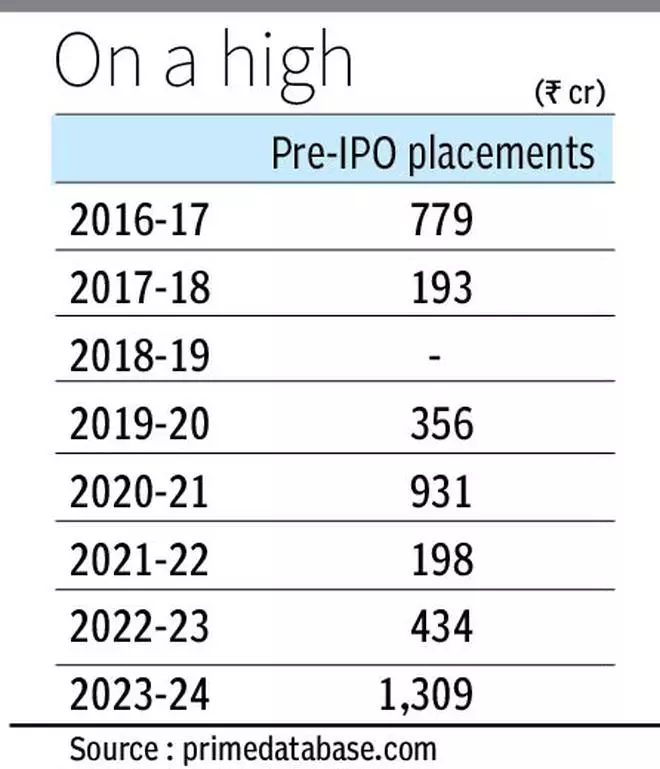Companies that made their debut on the bourses in the last financial year raised over ₹1,300 crore by way of pre-IPO placements.
This is three times the amount collected through this route in the last fiscal and the highest mop-up since FY17, the year from which data is available. The amount is 1.93 per cent of the funds mobilised through IPOs in FY24.

The previous highest mop-up from such placements was in FY21 when companies raised ₹931 crore, making up 2.95 per cent of the total amount raised through IPOs that year, data from primedatabase.com, a primary market tracker showed.
Companies that garnered the most by way of such placements in FY24 include Rashi Peripherals (₹150 crore), SBFC Finance (₹150 crore), Jupiter Life Line Hospitals (₹123 crore) and Yatharth Hospital & Trauma Care Services (₹120 crore).
Pre-IPO investing refers to buying shares in a company before the issue actually opens and is typically done after the draft prospectus is filed and before the issue opens for subscription.
“Companies are able to get a pricing benchmark for their issues through a pre-IPO placements and also potentially get some marquee investors on board. Investors are assured of a certain allocation at a certain price, which may or may not be the case if they invest through the anchor or qualified institutional buyer book,” said Pranav Haldea, Managing Director, PRIME Database Group.
According to Haldea, pre-IPO placements could be particularly useful for smaller IPOs as getting marquee investors can add credibility to the issuance. Mid and small-cap companies dominated the IPO scene last year. The average deal size reduced significantly to ₹815 crore in FY24 compared to ₹1,409 crore and ₹2,105 crore in the previous two years.
The decision to do a pre-IPO is taken by the company in consultation with the investment bankers. Such placements are particularly targeted at wealthy investors and family offices.
IPO allotment
From April 1, 2022 the market regulator changed its rules for IPO allotment for wealthy investors. One-third of the shares under the NII category are allotted to HNIs with an application size of ₹2-10 lakh. The remaining is for applications of over ₹10 lakh.
“HNI allotments are now done through draw of lots. Earlier, if you put in a bid of ₹100 crore and the issue was subscribed 100 times you got an allocation of ₹1 crore.
New rules
Under the new rules, there is no guarantee that an HNI will get a higher allotment just by putting in higher bids for well-subscribed issuances. This is one reason why wealthy investors now prefer investing through pre-IPO funds,” said Munish Aggarwal, Managing Director and Head - Equity Capital Markets, Equirus.
Pre-IPO investors must compulsorily hold the shares for six months from the time of the IPO. Anchor investors are subject to a lock in of 30 days post which can sell half their holdings and the rest after 90 days.
Pre-IPO shares can be allotted at any price while anchor allotment happens within the IPO price band.




Comments
Comments have to be in English, and in full sentences. They cannot be abusive or personal. Please abide by our community guidelines for posting your comments.
We have migrated to a new commenting platform. If you are already a registered user of TheHindu Businessline and logged in, you may continue to engage with our articles. If you do not have an account please register and login to post comments. Users can access their older comments by logging into their accounts on Vuukle.